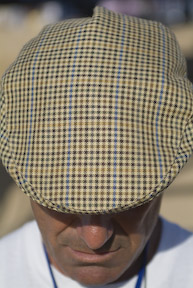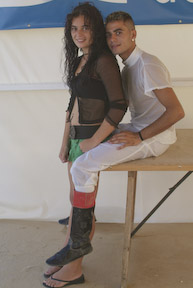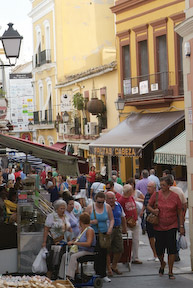A Portrait of Javier Hidalgo
POSTED ON 01/10/2008Javier Hidalgo is said to be on a watermelon diet. Actually, he’d like to be because he loves watermelon but it’s off limits because it’s bad for his digestion so he’s not really eating anything very much at all. You have to wonder if he ever does. Dressed in flat cap, short-sleeved shirt, high trousers and slip-on plimsolls, his wiry frame and cheeky Robbie Williams-like grin make him look more a jockey than the director of Bodegas Hidalgo La Gitana, Sherry-producer extraordinaire since 1792. But then as 5 – 1 favourite to win the €6,800 Cajasol Trophy he is about to mount Quiet Jaldun and race the 1,800 metres along the beach in front of virtually the entire population of Sanlúcar (pop. 65,000), a coastal town with a jaunty, village party atmosphere. In fact, he’s so keen on flat racing that he takes every opportunity, wherever he can in Europe, to hunt with the hounds.
 Javier Hidalgo
Javier Hidalgo
Despite the outward trappings of a man generally enjoying the life of Riley, Javier has spent has working life wearing out English gentlemen’s shoe rubber by tirelessly promoting the sherries, manzanillas and brandies of his long-established family company to more than 30 overseas markets. This at a time when Sherry has been in serious decline over a quarter of a century in its key markets of the UK, Germany, Holland and Belgium. Hidalgo survived the crash of the early 1980s when the sherry giant Rumasa brought Sherry to its knees by cynically turning it into a cheap commodity for people to get drunk on. Since then, the industry has been desperately trying to get back on its feet but the hard-to-shake cheap, sweet and old-fashioned image has resulted in surplus stocks and a vicious circle of pressure on the bodegas to supply cheap, own-label products.
Javier is convinced that the region needs to sell less own-label and to promote its brands. ‘We need to promote dry sherry as a wine to be drunk with food as the Spanish do, not a wine to be drunk on its own in a tiny glass, keeping the rest for next year, but in a big glass, chilled down, with food’. He points out that in Spain 60 per cent of Sherry sold is Manzanilla and another 20 per cent Fino. This puts Hidalgo in a good position in an ailing Sherry market given that three quarter’s of the production its family vineyards in Balbaina and Miraflores is of Manzanilla. Hidalgo make some glorious Sherries aged in the dark, quiet surroundings of the well-ventilated bodega, like the Amontillado Viejo (VORS), Oloroso Viejo (VORS), Palo Cortado Viejo (VORS) and Oloroso Añada 1986, but the mainstay of the range is La Gitana, the crisp, savoury, bone dry Manzanilla that goes so well with antipasti and seafood.
 Sanlucar Jockey and Girlfriend
Sanlucar Jockey and Girlfriend
Under the portrait of a beautiful woman with black flowing tresses hanging in the family study in the bodega, there’s a roguish glint in his eye as Javier tells the story of how La Gitana got its name. La Gitana is the gypsy barmaid who by all accounts captivated her customers in turn-of-the-century Malaga in general and Javier’s great grandfather Eduardo in particular. Mesmerised by her animal magnetism, Eduardo decided to call the family sherry after this exotic femme fatale, although when asked whether his great grandfather had an affair with her, Javier gives a non-committal shrug. ‘Who knows?’ he says, with a wistful hint of jealousy in his voice and the broadest grin imaginable.
It’s hard to imagine Javier as anything other than a young man, but it was nearly 60 years ago that he was born in Sherry’s Sanlúcar de Barrameda. He qualified as an agricultural engineer and biologist at the University of Seville and subsequently specialised in waterfowl and wetlands management and conservation. As a member of the board of the Sociedad Española de Ornitología (Spain’s answer to the British RSPB), he has written a great deal about wildlife management and conservation and was involved in the launch of the imperial eagle trust and the protection of the salt marshes. Although one of the many local windfarms that deface the landscape is his cousin’s, he’s campaigning against these unlovely 80-metre high turbines because of the danger they pose to the kites and swifts that migrate from here to warmer African climes. ‘I’d like to be a modern Don Quixote and tilt against these monstrosities, but I’d need a taller horse’, he says. And the race? Let’s just say I lost my 5 – 1 bet, but drowning your sorrows in La Gitana can be very consoling.
 Sanlucar market
Sanlucar market

